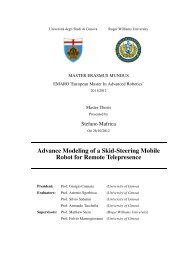RWRCCL - Roger Williams University
RWRCCL - Roger Williams University
RWRCCL - Roger Williams University
Create successful ePaper yourself
Turn your PDF publications into a flip-book with our unique Google optimized e-Paper software.
III. THE JOINT-LEVEL CONTROL SYSTEM<br />
Real-Time Linux provides the facilities for creating a<br />
periodic task and controlling its execution. To ensure the<br />
real-time thread never blocks, all communication with<br />
asynchronous (regular Linux) processes occurs through Real-<br />
Time FIFO (RTF) queues. The real time process can write to<br />
these queues without blocking and can perform read<br />
operations if there are data available. Part of the real-time<br />
process can be initiated when data are available on an RTF,<br />
thus making it possible to initiate, control the execution and<br />
suspend the real-time process from a regular Linux process<br />
through appropriate writes to the RTF.<br />
The real-time process is a module that must be loaded into<br />
the kernel before execution of an <strong>RWRCCL</strong> program. The<br />
process will remain suspended until activated, so there is no<br />
significant penalty in loading the modules at boot time. The<br />
periodic process executes at 1 kHz to mimic the frequency of<br />
the original joint servo control cards. Our hardware is a<br />
600MHz Pentium III on 133 MHz bus with 128 MB RAM.<br />
We developed the closed loop control making heavy<br />
reference to the technical report “The PUMA Servo<br />
System”[9] by Peter Corke [10]. Initially, we verified that<br />
the dynamic model parameters presented in the report<br />
reflected the dynamics of our PUMA, and these did<br />
remarkably well. Using MatLAB, we built a state-space<br />
controller based on the verified model, but were disappointed<br />
to find the floating-point operations caused clock overruns of<br />
the Joint-Level Servo process. We compromised with a<br />
straightforward P-D control with some filtering, as shown in<br />
Figure 4. More recent versions of RealTime Linux offer<br />
support for floating point operations, and a 600MHz PIII can<br />
no longer be considered a “fast processor”, so there is a<br />
possibility for more sophisticated control with improved<br />
hardware.<br />
Figure 4 P-D controller for joint level servo<br />
The performance of the P-D control is not particularly<br />
good, as can be seen by the graph of Joint 2 control as shown<br />
in Figure 5. We see the P-D control lags the Setpoint and<br />
filtered Setpoint curves and has a steady-state error. In the<br />
motion shown the steady-state error is 33 encoder counts or<br />
approximately 0.15 degrees. Steady-state error in the P-D<br />
control is determined by friction and gravitational loading and<br />
therefore will be position dependent. For a large motion (e.g.<br />
30 degrees) the trajectory generator changes the Setpoint<br />
stepwise as can be seen in Figure 5. This introduced some<br />
notable jitter in the robot motion, and we reduced this by<br />
adding the setpoint filter shown in Figure 4.<br />
We are relatively satisfied with this performance,<br />
considering our imprecise applications of online painting and<br />
education. Nothing we do with our robot requires great<br />
accuracy, so we are able to live with some controller “slop”<br />
and some “slumping” due to gravitational biasing. We<br />
acknowledge that this control may not be adequate for other<br />
users with applications requiring greater accuracy.<br />
Figure 5 Performance of Joint 2 P-D controller for 30-degree motion.<br />
IV. SYSTEM PERFORMANCE<br />
User programs written for the original RCCL system will<br />
execute on the <strong>RWRCCL</strong> system without modification. For<br />
example, all of the demo programs for the PUMA560<br />
included with the RCCL distribution were executed using<br />
<strong>RWRCCL</strong> after a simple re-compile.<br />
As shown in Figure 2, the trajectory generation process is<br />
a regular Linux process subjected to pre-emptive scheduling.<br />
The process blocks on a read to a real-time FIFO and returns<br />
from this read when there are data to be read, as shown in<br />
Figure 3. As a consequence, the trajectory generation process<br />
is not truly synchronous and this has some small but<br />
noticeable effects on the robot motion.<br />
We find occasional variation in the completion time of<br />
commands as the robot may pause slightly during a motion.<br />
We also find we can worsen this effect by loading the<br />
processor with time-consuming disk writes or screen<br />
refreshes. Again, utilizing a faster machine may alleviate<br />
some of these problems.<br />
V. ADDITIONAL ITEMS<br />
A. Robotsim<br />
A useful robot simulator robotsim is included in the original<br />
RCCL distribution. This provides a faithful simulation of an<br />
RCCL program controlling a robot via RCI. We modified<br />
robotsim to execute under the <strong>RWRCCL</strong> configuration. We<br />
again use a RealTime Linux module to generate real-time<br />
FIFO messages to the robotsim process. This is a kernel<br />
module similar to the Joint-Level Servo module but
















